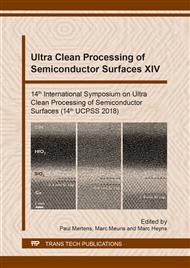p.13
p.19
p.25
p.31
p.39
p.43
p.48
p.52
p.59
Toward the Surface Preparation of InGaAs for the Future CMOS Integration
Abstract:
The integration of III-V and Ge materials on Si surface causes many issues with complexity such as lattice mismatch with silicon. In particular, the surface preparation and passivation of InGaAs is very challenging, because the formation of InGaAs/high-K interface is important, but not well understood. For the systematical study of InGaAs surface during wet processes, the effect of various wet etching processes on the surfaces of binary III-V compound semiconductors (GaAs, InAs, GaSb and InSb) was studied from the viewpoints of surface oxidation, material loss (dissolution), and passivation. Based on that, further effort to understand the surface reactions on ternary InGaAs compound semiconductor was made. In addition, process sequential effect on the InGaAs surface was investigated.
Info:
Periodical:
Pages:
39-42
Citation:
Online since:
August 2018
Authors:
Keywords:
Price:
Сopyright:
© 2018 Trans Tech Publications Ltd. All Rights Reserved
Share:
Citation:


